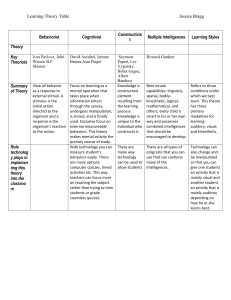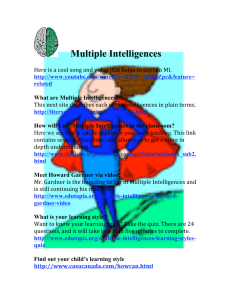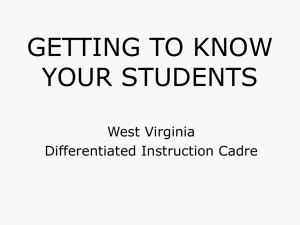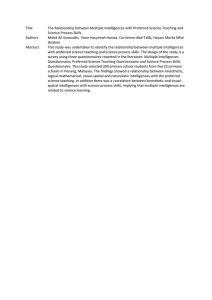Foundations for Training Excellence
advertisement
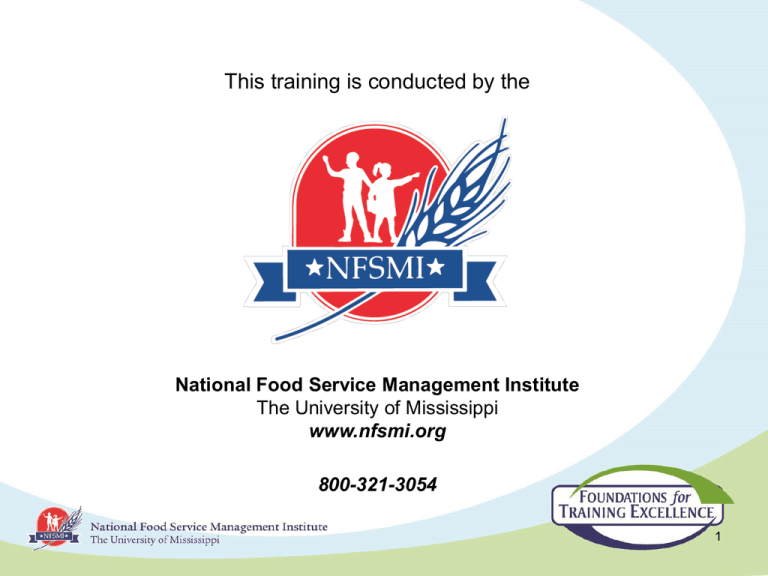
This training is conducted by the National Food Service Management Institute The University of Mississippi www.nfsmi.org 800-321-3054 1 2 Seminar Objectives 3 4 Section 1: Outcomes Participants will: • Have been introduced to all participants. • Understand the use of ice breakers and brain energizers in training classes. • Be able to recognize when and where breaks are needed in the training day. 5 Ground Rules 6 A Successful Trainer • Be prepared • Be participant-centered • Be able to effectively facilitate training using proven skills and techniques that – Engage participants – Maximize potential for knowledge transfer 7 Ice Breakers 8 Effective Ice Breakers • Help Participants Meet and Mix. • Set the Tone of the Meeting. • Fit the Audience and Training Topic. 9 Guidelines for Ice Breakers: • Must be appropriate to the particular group – tailor to each group and keep it simple. • Should not be too long – not to take away from the content of the training. Be clear about the limits. • Be enthusiastic. • Promote interaction and team building. 10 Get to Know an Ice Breaker 1. Training Questions 2. Business Card Introduction 3. The “Intro You Deserve” 11 Section 1: Opener What did you learn in this lesson? How are you going to use the tool? 12 13 Section 2: Outcomes Participants will: • Complete pre-training selfassessment tool. • Discuss the results with learning partner. 14 Importance of Self-Assessment 15 Self-Assessment 1. What did you learn from the self-assessment? 2. What is your greatest training challenge? 16 Section 2: Self-Assessment What did you learn in this lesson? How are you going to use the tool? 17 Break 18 19 Section 3: Outcomes Participants will: • Review the importance of advance planning for any training. • Understand why preparation checklists are essential to the success of training on any topic. • Explore the Tools and Tips for Trainers resources that are available from NFSMI. 20 Worst case scenario 21 Preparation Checklist 22 Challenge Activity 23 24 Section 3: Planning for Success What did you learn in this lesson? How are you going to use the tool? 25 26 Section 4: Outcomes Participants will: • Review six principles for training adult learners. • Apply principles of adult learning to training staff members. • Explore the concepts of Types of Intelligences for use in reaching adult learners. 27 Activity Brainstorm as many ideas as you can. • Use Post-It notes on table. • Write 1 thing you know about adult learners on each Post-It. 28 Principles of Adult Learners 1. Must be actively involved. 2. Have accumulated a foundation of life experiences and knowledge. 3. Are goal-driven. 4. Are relevancy-oriented. 5. Are practical. 6. Need to be shown respect. as characterized by Malcom Knowles. 29 Applying the Principles of Adult Learners 30 Switch It Up New Seats New Perspectives New Friends 31 Break 32 Types of Intelligences 33 Types of Intelligences LINGUISTIC: Ability to use words and language 34 Types of Intelligences SPATIAL: Ability to visualize relationships between objects or ideas in the mind 35 Types of Intelligences BODY/KINESTHETIC: Ability to use the body and motion 36 Types of Intelligences INTERPERSONAL: Ability to use person-to-person communication and relationships 37 Types of Intelligences INTRAPERSONAL: Ability to use the spatial, inner states of being, self-reflection, and awareness 38 Types of Intelligences LOGICAL/MATHEMATICAL: Ability to recognize patterns and number systems 39 Types of Intelligences MUSICAL: Ability to recognize audio patterns and sounds, as well as rhythms and beats 40 Types of Intelligences NATURALIST: Ability to understand the natural world and using this ability 41 Types of Intelligences What sounds like you? 42 Activity New Wheel of Intelligences • Fill in each segment with Learning Activities for Marketing Healthy School Meals 43 Section 4: Adult Learners What did you learn in this lesson? How are you going to use the tool? 44 Break 45 46 Section 5: Outcomes Participants will: • Identify six training objectives: knowledge transfer, comprehension, application, analysis, synthesis, and judgment. • Explain the various training methods that work best with each objective. • Link training objectives to methods of training. 47 Questions for preparing for your next meeting • Who is my target audience? • What are the training objectives? • How formal is your training session going to be? • How much “in class” time do you have? • Are these challenges that would affect outcomes? 48 Training Methods How will you keep the learner engaged? • Lecture • Games • Case Studies • Multimedia • Role playing • Dramatization 49 Broad Objectives • • • • • • Knowledge Acquisition Comprehension Application Analysis Synthesis Judgment 50 Knowledge Acquisition Built on Existing Knowledge or Learning Something Totally New 51 Knowledge Acquisition Methods • • • • • Lecture Watching movie or video Reading Listening to panel discussion PowerPoint slides 52 Comprehension • • • • • • Understanding Information Grasp Meaning Translate Knowledge into a New Context Interpret Facts Order or Group Predict Consequences 53 Comprehension Aha! • • • • • • Discussion Demonstrations Skits Problem-Solving Activity Games Case Studies 54 Comprehension Activity 55 Application Activity 1. Write an objective. 2. Plan two activities using two different methods. 56 Analysis Skills that can be demonstrated include: • • • • identifying patterns, the organization of parts, the recognition of hidden meaning, and the identification of individual components. 57 Synthesis Skills that can be demonstrated include: • using old ideas to create new ones, • generalizing from given facts, • relating knowledge from several areas, and • predicting or drawing conclusions. 58 Judgment Skills that can be demonstrated include: • • • • • comparing and discriminating between ideas, assessing value of theories and presentations, making choices based on reasoned argument, verifying value of evidence, and recognizing subjectivity. 59 Section 5: Matching Methods to Objectives What did you learn in this lesson? How are you going to use the tool? 60 Break 61 62 Section 6: Outcomes Participants will: • Review the Formatting Four. • Apply the Formatting Four to design a flier. • Apply Guidelines for Developing Effective Slide Presentations. 63 Formatting Four white space bolding headings bullets 64 Build a Healthy Base 1. Let MyPlate guide your choices. 2. Choose a variety of grains daily, especially whole grains. 3. Choose a variety of fruits and vegetables daily. 4. Keep food safe to eat. 65 Build a Healthy Base 1. Let MyPlate guide your choices. 2. Choose a variety of grains daily, especially whole grains. 3. Choose a variety of fruits and vegetables daily. 4. Keep food safe to eat. 66 Build a Healthy Base 1. Let MyPlate guide your choices. 2. Choose a variety of grains daily, especially whole grains. 3. Choose a variety of fruits and vegetables daily. 4. Keep food safe to eat. 67 Batch-Cooking Scrambled Eggs For scrambled eggs, cooking should be done in small amounts. A small batch of scrambled eggs is 3 quarts or less. Cook scrambled eggs until no visible liquid remains. When fresh scrambled eggs are brought to the steam table, use a fresh pan. Never mix two different batches of eggs. 68 Fruit Salads Select the form of fruit to be used for Fruit Salads: Fresh – wash fresh fruits in cool water before they are peeled or stemmed. Canned – chill canned fruits when they are to be served cold. Frozen – thaw frozen fruits in the refrigerator. Dried – rehydrate dried fruits in water or juice if desired. 69 Build a Healthy Base Let MyPlate guide your choices. Choose a variety of grains daily, especially whole grains. Choose a variety of fruits and vegetables daily. Keep food safe to eat. 70 Build a Healthy Base • Let MyPlate guide your choices. • Choose a variety of grains daily, especially whole grains. • Choose a variety of fruits and vegetables daily. • Keep food safe to eat. 71 Guidelines For Effective Slide Presentations 72 Three Main Components for Slide Presentations Content Visuals Delivery 73 Content No matter how great your presentation looks, nothing can make up for poor content. Here are two rules for creating an effective presentation. • Know your content. • Review before presenting. 74 Visuals Visuals consist of how the presentation feels. • • • • Fonts Backgrounds Slide layout Transitions • Animation • Graphics • Sounds 75 Delivery • • • • Practice, practice, practice Engage the audience Speak clearly NEVER read the slides 76 Improving PowerPoint Slides Activity 77 Section 6: Using Effective Materials What did you learn in this lesson? How are you going to use the tool? 78 79 Section 7: Outcomes Participants will: • Examine presenter styles and the impact on the learner. • Be introduced to facilitation and class management skills. • Be able to describe seven types of personalities and their associated behaviors. 80 Section 7: Outcomes, continued Participants will: • Review how each personality affects the dynamics of a training session. • Explore how to respond to various conflicting behaviors. • Observe and use four techniques to answer questions. 81 Presenter’s Style What did you observe about the presenter’s style today? 82 Essentials of Style • • • • • • Body Language Movement Interaction with Participants Appearance Attitude Flexibility 83 Presenter’s Pitfalls 84 Participant-Centered Training Activity • • • • Expertise Empathy Enthusiasm Clarity 85 Facilitative Trainer “Has the skills to facilitate learning with the responsibility for teaching some particular topic.” Roger M. Schwarz 86 Responsibilities of a Facilitative Trainer • Analyze Audience • Monitor Group Process • Whether Training Is Meeting Participant Needs • Facilitates the Interaction Among Participants to Enhance Learning 87 Managing Other Factors • • • • Know Your Audience Size of Group Flow of Training Day Manage a Work Lunch 88 Physical Activity 89 Break 90 Managing Personalities • • • • • • Know-It-All Timid or Bashful Whiners Avoiders Talkers Arguer 91 Personality Scenarios 92 Techniques for Answering Questions • • • • Answer Directly Postpone Answering Admit You Don’t Know the Answer Answer Indirectly 93 Activity If you were to develop a plan for Marketing Healthy Meals what would you do to ensure you communicate information to both students and school staff? 94 Section 7: Management What did you learn in this lesson? How are you going to use the tool? 95 96 Section 8: Outcomes Participants will: • Identify appropriate closing activities. • Review the reflection notes made during the workshop. • Complete the Self-Assessment. • Complete the Evaluation. 97 Circle of Reflection 98 Post-Training Self Assessment 99 Training is an Evolving Process • Always learning from experience. • Always learning how to improve. 100 Section 8: The Closer What did you learn in this lesson? How are you going to use the tool? 101 NFSMI Course Evaluation 102 Thank You! NFSMI Contact: 800-321-3054 www.nfsmi.org 103 National Food Service Management Institute The University of Mississippi • Mission: To provide information and services that promote the continuous improvement of child nutrition programs • Vision: To be the leader in providing education, research, and resources to promote excellence in child nutrition programs 104
